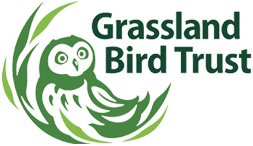Content courtesy of Capital-Mohawk PRISM
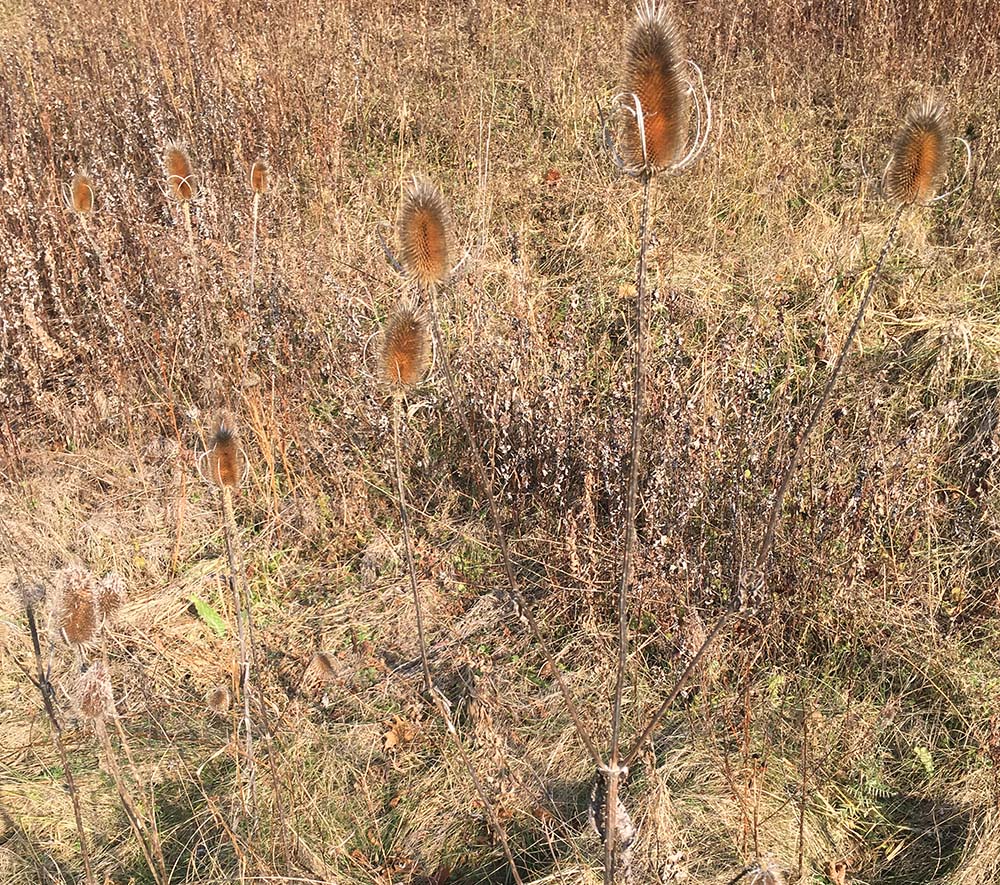
Dispsacus laciniatus, Cut-leaf Teasel
The Cut-leaf Teasel is often found in open habitats such as roadsides, prairies, savannas, or meadows. It is easily spread due to the production of abundant seeds.
Description: This perennial plant grows as a basal rosette, which develops into a tall flower stalk (reaching up to six feet tall). This species has opposite leaves at the base that are long and pinnately lobed, coarsely toothed, and ciliate. The tall flower stalks are often covered in white prickles with smaller opposite leaves at intervals along the stalk.
Control: This species is often difficult to effectively manage. Removing the plant manually by pulling or digging may help control the spread but often, remaining portions of the taproot regenerates the plant.
Look-alikes: This species may resemble the Leavenworth’s eryngo (Eryngium leavenworthii) or the Common Teasel (Dipsacus sylvestris), although it can be distinguished by the difference in coloration. During the rosette stage, the Cut-leaf Teasel looks similar to Wild Lettuce (Lactuca spp.), but once the flower stalks develop they can be distinguished.
Flower Time and Description: Flowers are present from July – September. Each stalk ends with a cylindrical flower head. At the base of this flower head, there are several sharp bracts that stick out. The individual flowers are densely packed together on the flower head. After flowering, seeds are bunched together at the top of the stalk.
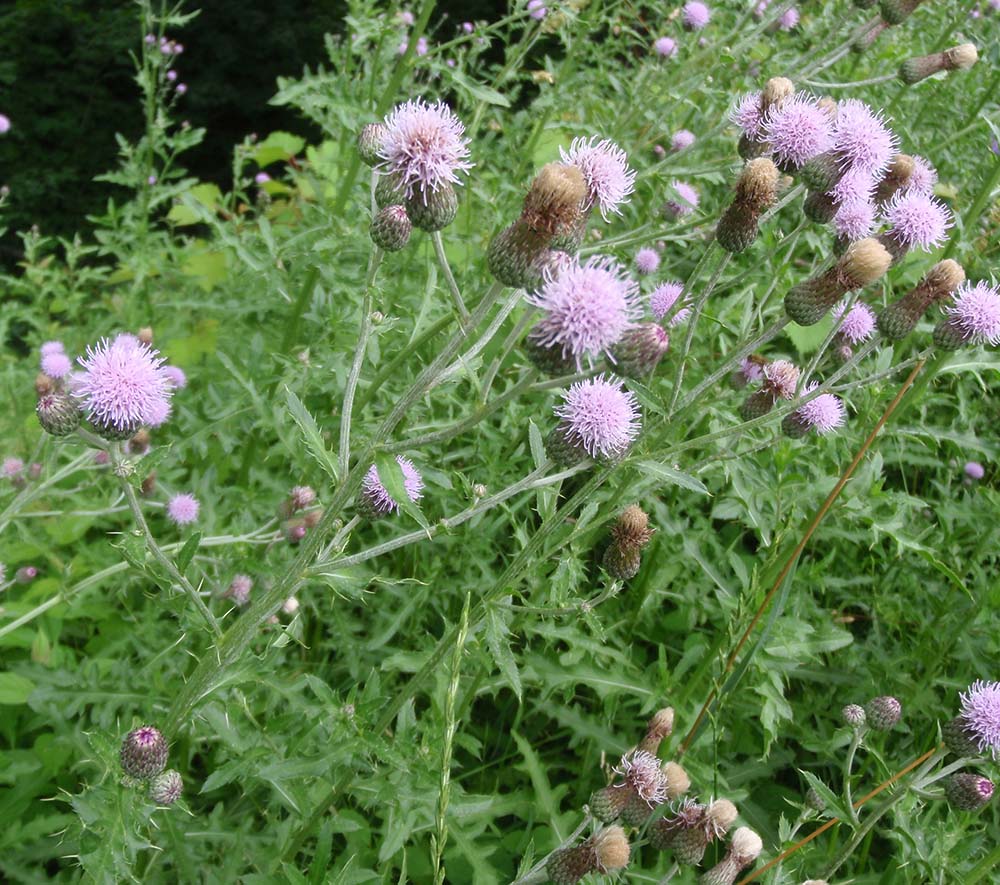
Cirsium arvense, Canada Thistle
The Canada Thistle is a rhizomatous perennial plant that is native to Europe and Asia. It is shade intolerant, so it is rarely found within wooded areas and prefers open fields and grasslands.
Description: This herbaceous plant can grow 1 -3 feet tall, branching more in the upper half of the plant. Leaves are dark green, with the undersides having short, prickly white hairs. The basal leaves are 5-8 inches in length and arranged alternately on the stem.
Control: This plant can be controlled by the repeated use of herbicides. The thistle can also be managed by mowing while the plant is in flower for multiple years.
Look-alikes: There are several native and exotic thistle species that are difficult to distinguish between, one being the Field Thistle (Cirsium discolor). Bull thistle (Cirsium vulgare) is similar and common in the region but has
much more pronounced spines and thicker leaves.
Flower Time and Description: Flowers bloom from June to August. This species has female and male plants; female flowers are fragrant and larger than male flowers. Flowers on the Thistle may range from purple, pink to white.
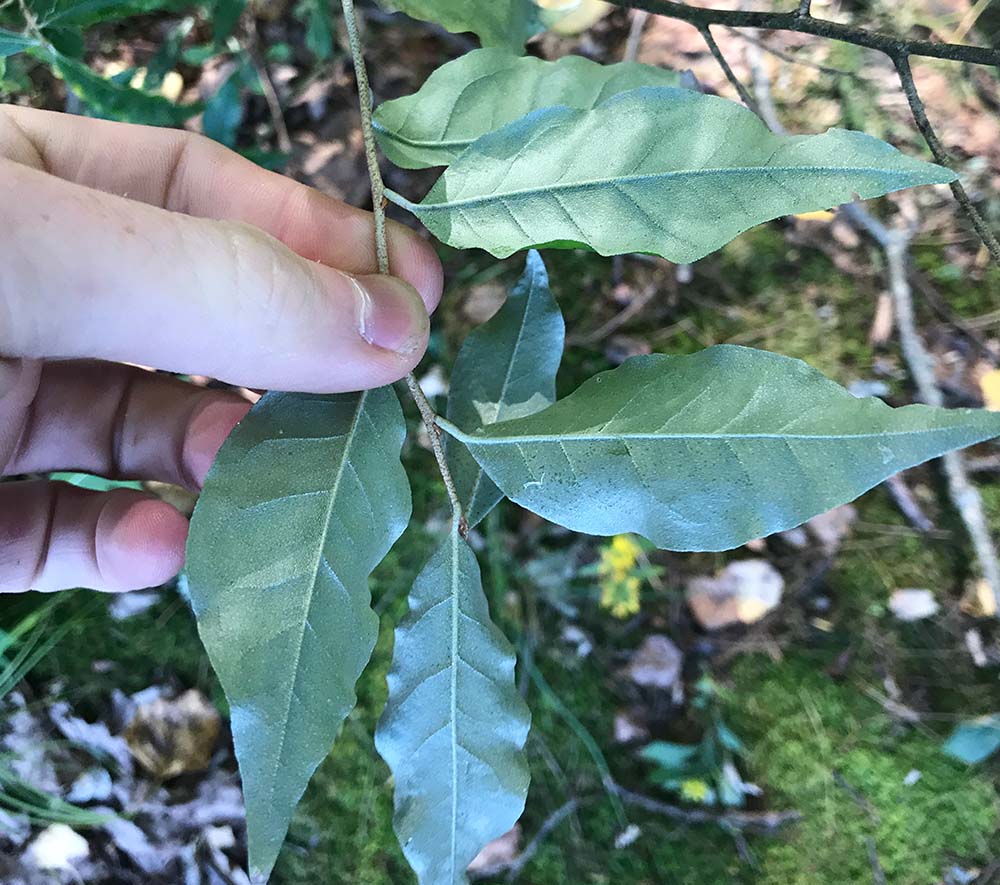
Elaeagnus umbellata, Autumn Olive
In the 1950s, Autumn Olive was promoted throughout the US as a way to control erosion and provide wildlife with food in disturbed habitats. This plant is native to China, Japan, and Korea. Autumn Olive is an invasive plant that outcompetes and displaces many native plants. It grows to form dense patches, blocking the sun from the plants underneath. This plant also has nitrogen fixing root nodules that allow it to grow in a variety of unfavorable conditions. This plant is a problem due to high seed production, high germination rates, and the general hardiness of the shrub.
Description: Autumn Olive can grow up to 20 feet tall and 30 feet wide. The stems are a brown with speckles, and often have thorns, especially at a young age. The elliptical leaves are greyish-green with scales on the bottom.
Control: One way to control Autumn Olive is by mechanically pulling the plant from the ground before fruiting. Larger plants may be removed with herbicides, applying herbicides to the cut stump.
Look-alikes: You can distinguish the Autumn Olive from other similar looking plants by the silvery scales on the lower leaf surface. The Silverberry (Elaeagnus commutate) is one related plant that resembles the Autumn Olive.
Flower Time: The flowers bloom in the early spring (April-June). Flowers appear in clusters with small cream/pale-yellow petals that are bell-shaped. The fruits are small brown berries that turn a speckled red over
time.
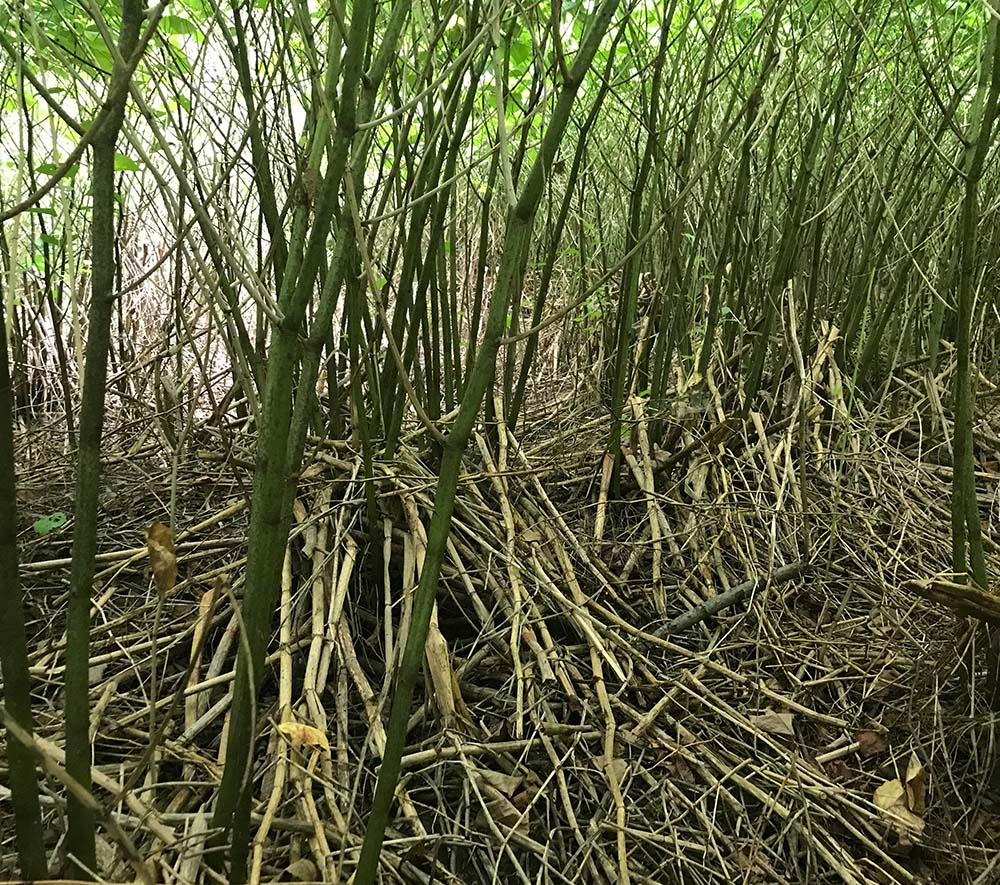
Fallopia japonica var. japonica, Japanese Knotweed
Japanese Knotweed was introduced from Eastern Asia and spread rapidly throughout the Northeast. This plant can reduce species diversity, alter natural ecosystems, and negatively impact wildlife. Once Japanese Knotweed is present, it is very persistent and hard to manage.
Description: This perennial has light green stems, often with reddish flecks. The plant is branched and can grow 3-4.5 meters in height. The leaves are broadly ovate with a rounded base and pointed tip. They are arranged alternating on the zig-zag stems. These leaves can be 3-6 inches long, often appearing to be slightly heart shaped. During dormancy, the plant appears reddish-orange as seen in the bottom picture.
Control: Due to an extensive rhizome system, Knotweed can be difficult to control. Small plants may be removed mechanically, though it is only effective if all of the roots are pulled up. Herbicide can be applied to the stems of knotweed to provide control.
Look-a-likes: Giant Knotweed (Fallopia sachalinensis) has many similar characteristics to the Japanese Knotweed, although it is typically much larger. Another similar species is the Himalayan Knotweed (Polygonum polystachyum), which can be distinguished having slightly hairy stems and more slender leaves.
Flower Time and Description: This plant flowers from August to September with offwhite flowers that show in clusters of 3-6.
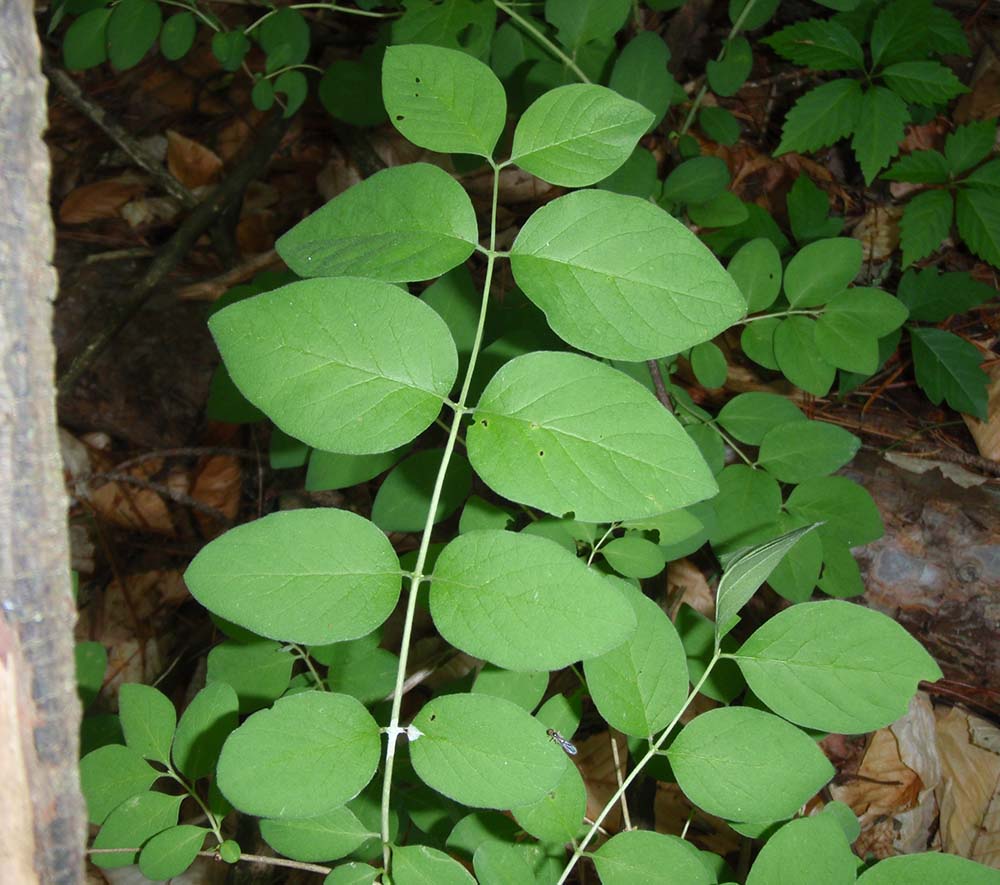
Lonicera tatarica, Tatarian Honeysuckle
This honeysuckle is native to central Asia and southern Russia. It has spread throughout many natural areas in the US and is one of the most common woody plants in the capital region. This plant commonly inhabits woodlands, roadsides, hedgerows, and thickets. Honeysuckle shades out native vegetation due to its habit of leafing out very early in the spring.
Description: This shrub can grow 5-12 feet tall. The branches are long, arching out and dividing into smaller leafy branches. The older bark is a gray-grayish brown with longitudinal ridges. As the branches age, they may become shaggy in appearance from shedding of the bark, which can be used to differentiate this plant from native honeysuckles. The leaves are opposite with an oval shape, tapering to a point at the tip.
Control: Mechanically removing the whole shrub can effectively control honeysuckle when it is smaller. As with most invasive shrubs, it is best to do this before or while the plant is in flower. Larger honeysuckle can be treated by the cut stump method of herbicide application.
Look-alikes: Tatarian Honeysuckle can be identified from other honeysuckles by the color of its flowers and by the lack of hairs on the leaves.
Flower Time and Description: The blooming period for this honeysuckle is from late spring to early summer, lasting about 3 weeks. The flowers are white to rosy-pink, having 5 lobes that are long and narrow. Afterwards, red berries replace the flowers.
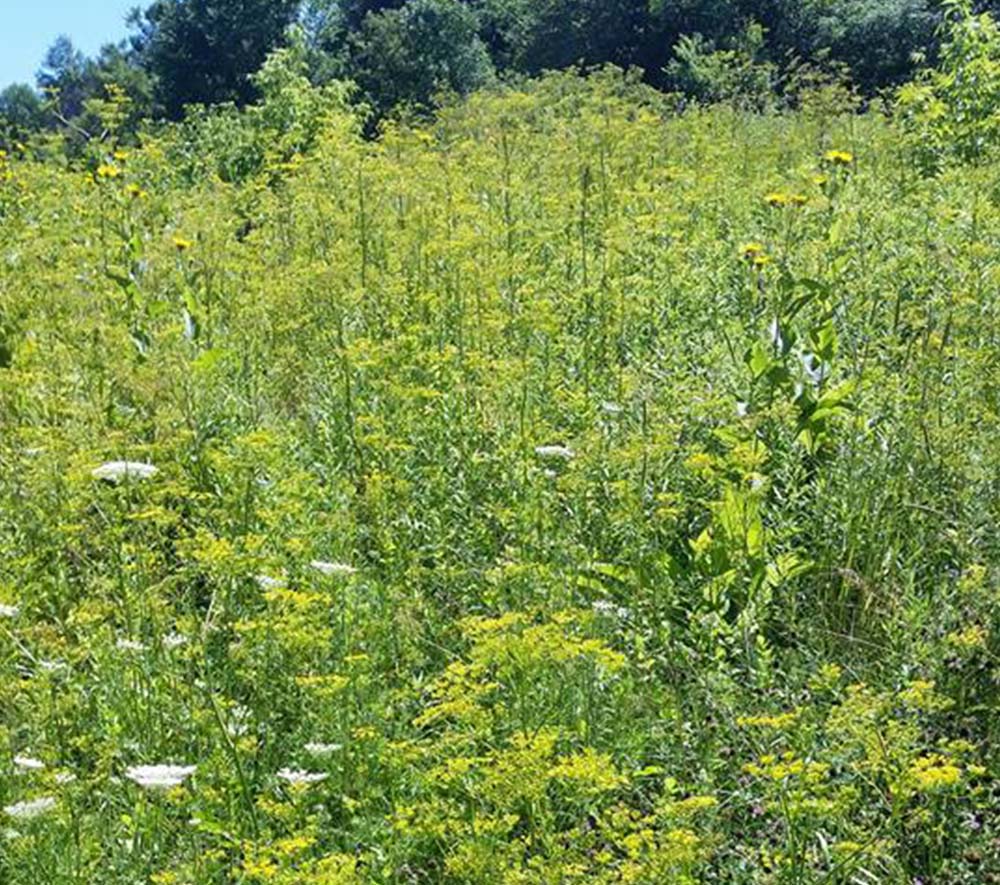
Pastinaca sativa, Wild Parsnip
Wild Parsnip is native to Europe. It is common in several different habitats including prairies, savannas, pastures/fields, meadows, roadsides, or vacant lots. This plant contain chemicals that may cause burn-like rashes on people which is triggered by contact with sunlight.
Description: This plant can grow to two to five feet tall. The leaves are alternate and oddly pinnate with about nine leaflets. The lower compound leaves can grow to 18 inches long and sic inches across, while upper leaves are much smaller with short petioles. The individual leaflets are three to two inches in size, an elliptic shape, and oppositely arranged. These leaflets also typically have serration on the edges. The upper stem of the Wild Parsnip comes together to form a flat-topped,compound umbel of tiny yellow flowers.
Control: Small patches can be controlled through manual cutting of the roots (1 inch below the ground), or pulling of the plant from the ground (including roots). These methods should be conducted before wild parsnip produces seeds. If controlling the plants with seeds, cut the top of the plant with clippers and then bag the seeds in a clear plastic bag and allow them to rot.
Look-alikes: Wild Parsnip may be confused with other plants in the Carrot family. The umbel is the most distinctive feature.
Flower Time and Description: Each plant can produce hundreds of small yellow flowers, blooming from June to mid-July. These umbels may reach up to 8 inches across, with a flat top. The individual flowers are quite small with five yellow petals.
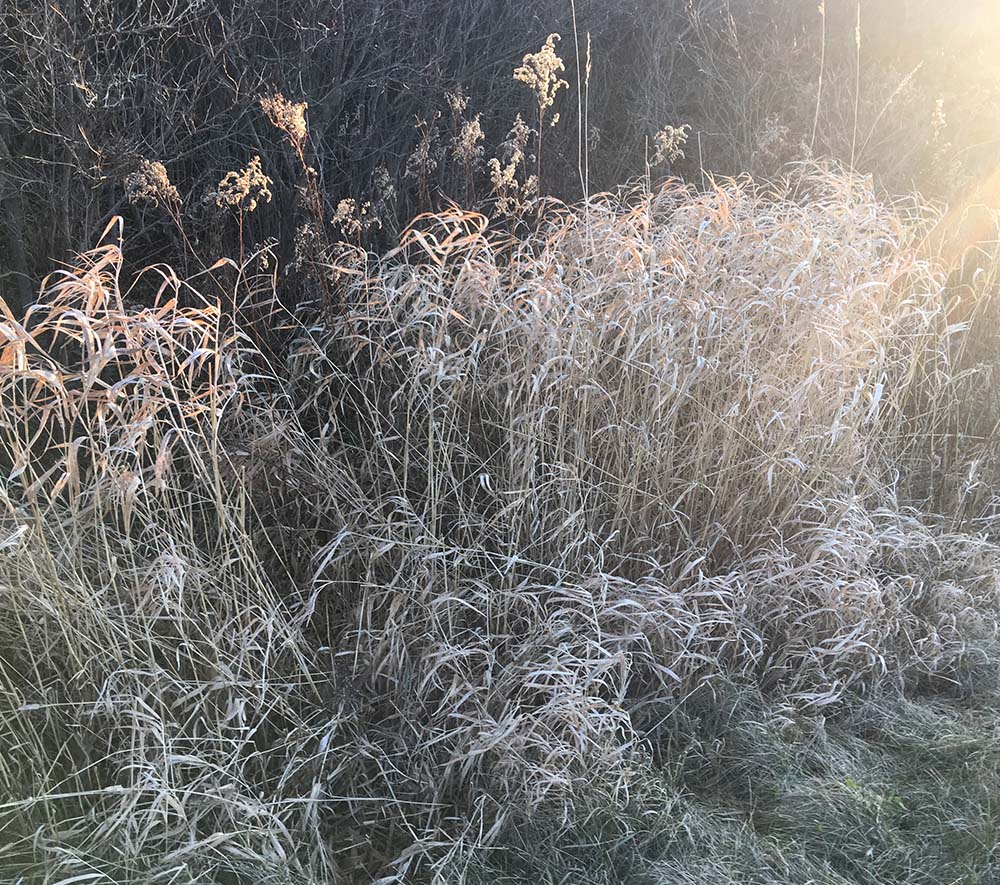
Phalaris arundinacea, Reed Canarygrass
This grass is native to North America and Eurasia, often being planted in the US for erosion control. This plant has a root system that produces extensive rhizomes. It spreads quickly, forming dense colonies that can overgrow other plants. It often inhabits wetland
areas.
Description: Reed Canarygrass can grow up to 5 feet tall, leave blades being 10 inches long. These leave blades are green/grayish-blue, linear in shape, and have a rough texture. The highly transparent ligule on reed canary grass is helpful in distinguishing it.
Control: Timing is very important for controlling this species as if it is cut during the growing season, a second growth spurt occurs in the fall. Consecutive annual burns in the spring or fall, or mowing mid-June and October may work to reduce growth and promote native species. Chemical methods may also be used, with fall application being more effective.
Look-alikes: The Reed Canarygrass is easily confused with another canary grass of the same genus, Canary Grass (Phalaris canariensis). This species is shorter and less aggressive than the Reed Canarygrass. Reed canary grass also resembles non-native orchard grass (Dactylis glomerata), but can be distinguished by its wider blades and narrower, more pointed inflorescence.
Flower Time: The clum of the Reed Canarygrass terminates in a skinny cluster of spikelets, reaching up to 10 inches long and 2-3 inches around. These spikelets change from a light green to a golden tan color over time.
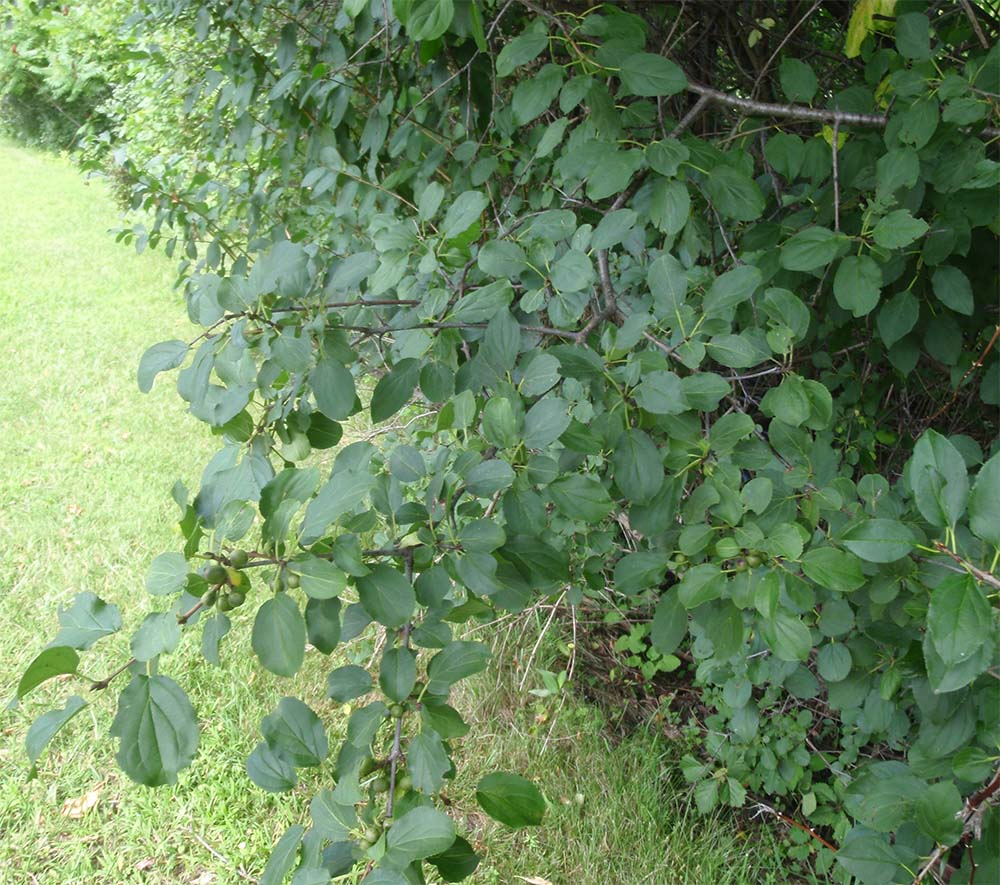
Rhamnus cathartica, Common Buckthorn
Common Buckthorn comes from Europe and western Asia. Growth of this plant crowds out native vegetation, due to its dense growth. The plant can also influence the chemistry of a habitat by leaving a high concentration of nitrogen in the soil. In addition, the decomposition of the leaf litter changes soil nitrogen content and can increase the pH levels of the soil.
Description: Buckthorn is a large shrub that can grow up to six meters high. It has dark green, egg-shaped leaves that are typically lighter on the underside. These leaves have prominent leaf veins that curve as they approach the rounded tip. They are arranged alternately, but may appear close to opposite. The plant has small thorns at the tip of its branches.
Control: Continuous mowing/cutting has been seen to cut populations, but manual control of this plant is difficult. The seeds may persist for up to five years. Research into more biological controls are currently in progress.
Look-alikes: Common Buckthorn can be distinguished from other Buckthorns by the sharp, thorn tipped branches and noticeable forward curved side veins on its leaves. In addition, the clusters of purplish-black berries that ripen in August/September are distinctive.
Flower Time and Description: This plant flowers during the late spring (May-June). The flowers are small with four sepals and four petals, forming clusters from the axis of leaves or on short twigs along the stem.
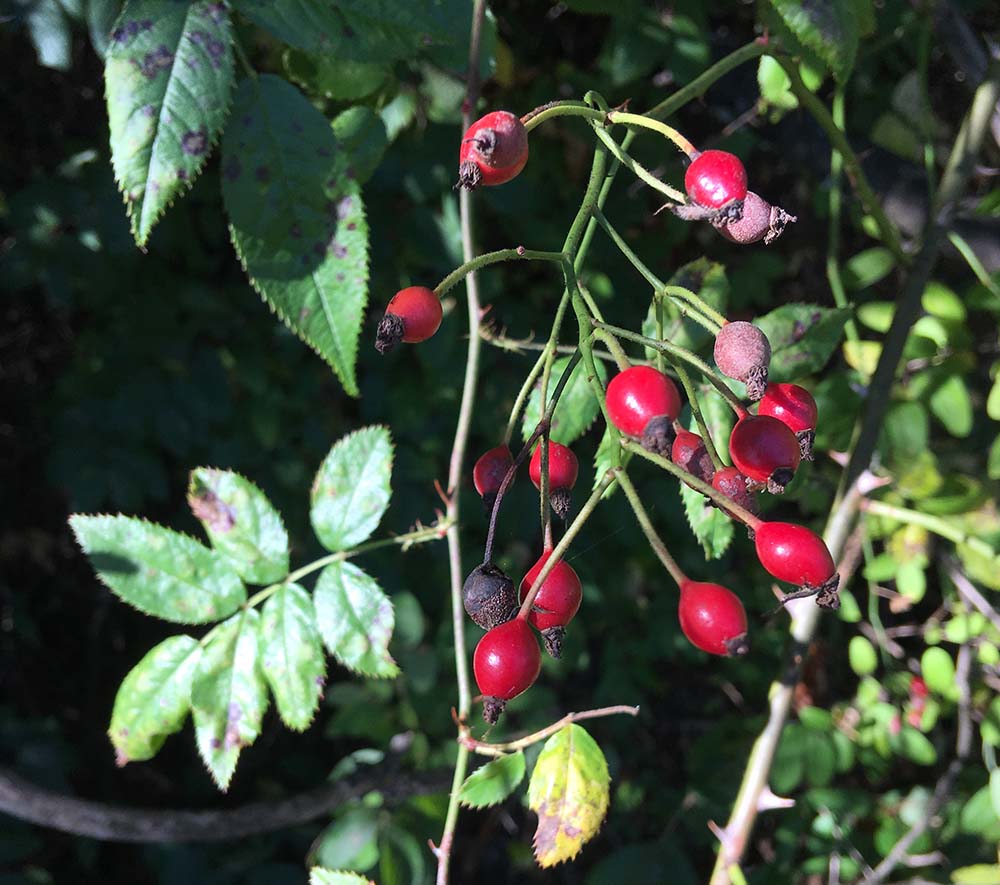
Rosa multiflora, Multiflora Rose
Multiflora Rose is native to eastern China, Japan, and Korea. It can easily form dense thickets, outcompeting many other species. It is commonly found in woodlands, forest edges, pastures/fields, roadsides, and swamps/marshes.
Description: This plant had red to green twigs with recurved thorns. The compound leaves grow alternately with a variable but odd number of oval, toothed leaflets. These leaflets smooth on the upper side, and have tiny hairs underneath. This plant can grow up to 10-15 feet high with a width of about 9-13 feet.
Control: Multiflora rose can be removed manually by pulling or digging, but all roots must be removed. Mowing (at a rate of three to six times per growing season for two to four years) have shown good reductions of multiflora rose as well. Some success has been seen from utilizing goats for controlled grazing. Herbicides may also help, but due to the long-lived seed bank, multiple treatments are necessary. Biological controls are being researched further and Rose Rosette Disease is having a noticeable impact on this species.
Look-alikes: The base of each leaf stalk has winged and feathered stipules, often very good to use to distinguish between other species. Wild Climbing Rose (Rosa setigera) resembles Multiflora Rose, although it has compound leaves with fewer leaflets and pink flowers. Flower Time and Description: Flowers bloom in late May or June, typically in clusters of small white/white-pink flowers. These flowers have five petals with clumped, yellow anthers in the center.
Donate!
Become a proud supporter of grassland bird conservation with your donation.
Your support makes a lasting difference!
